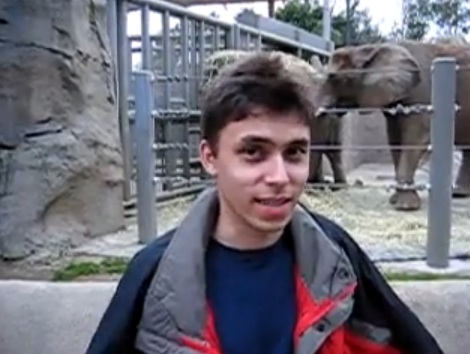Review: Me At The Zoo

Me at the Zoo Still
The composition within Me at the zoo, at first directs our attention into the belief that the protagonist is the point of the clip. Though our eyes remain focused on him, we are given a chance to participate with his environment; we are directed toward the elephants at the end of his statement about “really, really long trunks…” , which is reinforced when he turns to view them. Just as we share in this moment, he finishes with “And that’s pretty much all there is to say.” The clip comes to an abrupt end, and we are left with our memory of the events that have occurred. Yet the events and the clip are separate. What we, as internet audience members, have come to realize is that our memory of interaction is reliant upon another’s world has come into our own via the thin conduits of technology. There’s no way in which an elephant and a zoo can be transported into my own space, and yet we’ve been able to participate with jawed as if it’s really been possible.
What is called to mind is an “elephant in the room,” and in this case the elephant has literally ended up in my room. Yet this process goes un- verbalized, and at this point in time, these facts go overlooked because of the medium’s intuitive process of connection. The oversimplified consumption glosses over the complex nature of internet clip participation, a nature beyond (now) simple Hitchcockian voyeurism that I find more phrased as “Interception”. This intimate commingling of human optics and virtual feeding, through signals pretending to be real moments, are only sustained by the need for a continuity not actually offered (even via the perpetual lifecasting of Justin.tv). This much needed continuity of reality is conveyed through physical boundaries, one cannot participate with another human’s thoughts like puppeteer Craig Schwartz in Being John Malkovich, yet the internet does allow us to participate with something that is not present in a way that film/video/television does not afford so successfully: immediacy and control over such.
The enactment of free-will and the spontaneity of life find metaphor in this moment of Interception with jawed’s clip. No longer are we just watching, through the personal control over technology we can immediately re-watch, we can concretely recall, and we can immediately respond. All these actions suggest there is in fact something real happening, and the importance is larger than just the implied simplicity of the clip. There is much more to say beyond the bare facts of elephants possessing long trunks, they have found a new form of existence within any moment of Interception. This new realm of existence is completely different than any historically mediated interaction, perhaps the closest media-analogy of contemporary multi-verse theory. This elephant is no longer trapped within the bars of the zoo, which have taken on a metaphorical outlay of previous film/video footage. This elephant now resides within a virtual existence both nowhere and everywhere –a talent of the internet medium that film/video/television is not afforded.
“Me at the zoo” was uploaded to Youtube on April 23rd, 2005, making it the first video ever on the site. You can view it here.